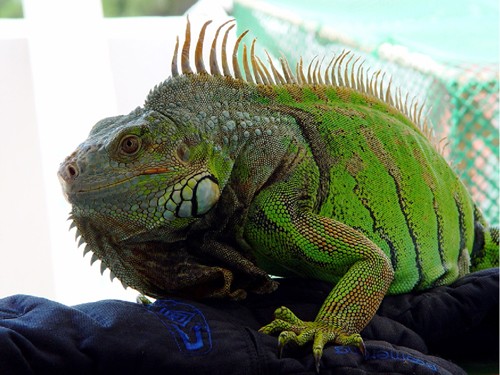Green or Common Iguana (Iguana iguana)
Download the Care of the Green Iguana client handout PDF.
Natural history
The green iguana is native to the tropical rain forests of Latin America. Most pet iguanas are raised on farms in El Salvador and Costa Rica although wild-caught imports and domestically captive-bred lizards are also available.
Taxonomy
Class: Reptilia
Order: Squamata
Family: Iguanidae
Iguanas, chuckwallas
Color and Size
Juveniles should be a bright green color although color becomes less vivid as the lizard ages. All ages have dark vertical bands on the tail. Breeding males may also have an orange tinge. Red and albino color morphs have also been developed.
Including the tail, adults can reach 1.8 m (6 feet) or more.
Diet
Green iguanas are herbivores.
- Dark, leafy greens should make up the majority of the adult diet. Offer a variety including collard greens, kale, romaine, dandelion greens, turnip greens, mustard greens, beet greens, bok choy, Swiss chard, spinach, chicory, and escarole.
- Mix greens with other chopped or grated vegetables like squash, zucchini, sweet potato, broccoli, peas, and carrots.
- Fruit should make up no more than 5% of the diet and should include nutrient dense items such as papaya, melon, and banana.
- Occasional treats may consist of non-toxic flower blossoms such as hibiscus.
Dust the non-breeding adult’s diet with a calcium carbonate or calcium gluconate supplement once weekly. Calcium supplements should be devoid or low in phosphorus with a minimum Ca:P ratio of 2:1. A general vitamin/mineral supplement can also be offered once weekly.
Husbandry
| Temperature | The green iguana has a preferred optimal temperature zone of 80-88°F (27-31°C). The basking spot should reach 92-95°F (33-35°C). |
| Humidity/water | Green iguanas will often soak in their water bowl and can defecate in their water. Drinking and soaking bowls should be cleaned at least daily. Iguanas should be misted daily with warm water. |
| Cage size and design | Adults require very large arboreal enclosures (i.e. 6 x 3 x 6 ft or 2 x 1 x 2 m) so custom built cages are often needed. Screening is best for adequate air circulation although more effort will be needed to keep humidity levels high. |
| Cage furniture/supplies | Provide a full-spectrum light source for normal absorption of dietary calcium. Iguanas are arboreal, and are most comfortable when provided with climbing structures. Offer sturdy branches to support heavy-bodied adults. |
| Social structure | Iguanas are solitary and territorial. |
Lifespan
Green iguanas can live up to 15-20 years when cared for properly.
Anatomy/ physiology
| Gastrointestinal: | The tip of the tongue is normally a dark red color. |
| Dermatologic: | Adult iguanas have a dewlap, or flap of skin, beneath the mandible.Unlike snakes, lizards normally exhibit a patchy shed or “ecdysis”. |
| Cardiopulmonary: | Unlike many lizards, the iguana heart is located just caudal to the thoracic inlet. Lizards possess incomplete tracheal rings. |
| Urogenital: | The paired kidneys are found within the pelvic canal. The green iguana has a thin-walled bladder. In the Western hemisphere, the breeding season is typically between October to June. |
| Sexual dimorphism: | Male iguanas have a hemipenal bulge. The hemipenes is the male copulatory organ. Males also tend to be larger in size with larger dorsal spines, dewlap, and femoral pores when compared to the female iguana. Femoral pores are the opening through which glands produce a thick, waxy secretion. This secretion plays a role in scent marking and other pheromone-based communication. |
| Miscellaneous: | Nasal salt glands excrete excess sodium. Iguanas “sneeze” clear, high sodium fluid, which later dries as a fine, white powder.Two or more fat bodies are found in the caudal abdomen. |
Restraint
Never grasp iguanas by the tail. Green iguanas utilize tail autotomy, a defense mechanism that utilizes tail loss. A vertical fracture plane of fibroconnective tissue and cartilage runs through the body and part of the neural arch of each caudal vertebrae. The tail can fall off when grasped, sometimes when very little pressure is applied. The tail will regrow as a cartilaginous rod.
Iguanas can also go on the “offensive”. They can bite and twist, utilize their sharp claws to scratch the handler, and larger specimens use their tails as a whip and will direct tail lashes at human eyes.
Venipuncture
Ventral tail (coccygeal) vein (see Restraint above)
Ventral abdominal vein
(Jugular vein)
Preventive medicine
Regular physical examination
Consider elective castration and feeding high levels of plant phytoestrogens to reduce aggression in males.
Important medical conditions
- Abscesses
- Cystic calculi
- Egg binding or dystocia
- Foreign body ingestion
- Nutritional secondary hyperparathyroidism or metabolic bone disease*
*(Download the client handout: Metabolic Bone Disease in Reptiles and Amphibians). - Renal disease
**Login to view references**
References
References
Baer DJ, Oftedal OT, Rumpler WV, Ullrey DE. Dietary fiber influences nutrient utilization, growth and ry matter intake of green iguanas (Iguana iguana). J Nutr 127(8):1501-1507, 1997.
Jacobson ER. Biology, Husbandry, and Medicine of the Green Iguana. Krieger Publ. 2003.
Bartlett RD, Bartlett P, Griswold B. Reptiles, Amphibians, and Invertebrates: An Identification and Care Guide, 2nd ed. Hauppage, NY: Barron’s Educational Series; 2010.
Lightfoot T. Iguana medicine and surgery. Exotic Veterinary Seminars, July 20 2009. Available at: http://www.vin.com/Members/CMS/Misc/default.aspx?id=7061.
Lock BA. Reproductive surgery in reptiles. Vet Clin North Am: Exot Anim Pract. 3(3):733-52, 2000.
Pollock C. Basic information sheet: Green or common iguana. May 30, 2012. LafeberVet Web site. Available at https://lafeber.com/vet/basic-information-sheet-for-green-or-common-iguana/
